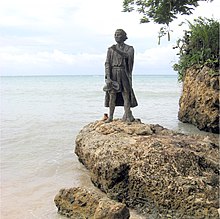| Holguín Province | |
|---|---|
| Province of Cuba | |
 Coat of arms Coat of arms | |
 | |
| Country | Cuba |
| Capital | Holguín |
| Area | |
| • Total | 9,209.71 km (3,555.89 sq mi) |
| Population | |
| • Total | 1,037,161 |
| • Density | 110/km (290/sq mi) |
| Time zone | UTC-5 (EST) |
| Area code | +53-024 |
| ISO 3166 code | CU-11 |
| HDI (2019) | 0.762 high · 13th of 16 |
| Website | www.Holguín.cu |
Holguín (Spanish pronunciation: [olˈɣin]) is one of the provinces of Cuba, the third most populous after Havana and Santiago de Cuba. It lies in the southeast of the country. Its major cities include Holguín (the capital), Banes, Antilla, Mayarí, and Moa.
The province has a population of slightly over one million people. Its territory exceeds 9,300 km (3,600 sq mi), 25 percent of which is covered by forest.
History

Christopher Columbus landed in what is believed to have been today's Holguín province on October 27, 1492. He declared that it was "the most beautiful land human eyes had ever seen".
The Holguín province was established in 1978, when it was split from the Oriente region.
Economy
Like much of Cuba, Holguín's economy is based around sugarcane, though other crops such as corn and coffee, as well as mining, are also large earners for the province.
A large nickel plus cobalt processing plant with shipping facilities was built in Moa, using foreign investment, much of it from Canada. Chromium, iron and steel plants dot the province as well.
Tourism has only recently begun to be developed, offering beach resorts in the outskirts of the region, with a number of hotels around the Guardalavaca area, Playa Esmeralda, Playa Yuraguanal, Playa Blanca, Playa Pesquero, and Cayo Saetia. The Cuchillas del Toa Biosphere Reserve, Sierra Cristal National Park and Alejandro de Humboldt National Park are partly located in the province. Gibara is a little visited historical port located west of the main Guardalavaca resorts. Recently a large number of tourists are reported to have visited the city and its rich culture and beauty. Direct flights to Canada and Europe from Holguin airport limit transfer time to around 1 hour to most resorts on the Costa Holguinera. Canadians and Europeans share the coral beaches with Cubans.
Municipalities
Holguín is divided into 14 municipalities:
OpenStreetMapDownload coordinates as:
- Source: Population from 2004 and 2012 Census. Area from 1976 municipal re-distribution.
Demographics
In 2004, the province of Holguin had a population of 1,029,083. With a total area of 9,292.83 km (3,587.98 sq mi), the province had a population density of 110.7/km (287/sq mi).
Per the 2012 census, the population was 1,035,072, and a similar population density of 111.38/km (288.5/sq mi).
Notable people
- Fulgencio Batista, last president and military dictator of the Republican era (1902-1959)
- Ángel Castro y Argiz, farmer and businessman, father of Fidel, Juanita, Ramón and Raúl Castro
- Fidel Castro, former President of Cuba
- Juanita Castro, former revolutionary, activist and writer
- Ramón Castro Ruz, revolutionary and politician
- Raúl Castro, former President of Cuba
- Rolando Masferrer, politician and business man
- Augusto Martinez Sánchez, revolutionary and former Minister of Labor.
- Aroldis Chapman, left-handed pitcher for the New York Yankees
- Frank Fernández, pianist
- Calixto García, General in the three liberation wars of Cuba
- Mario Kindelán two times lightweight boxing Olympic champion in 2000 and 2004
- Faustino Oramas, musician
- Marcos A. Rodriguez, entrepreneur and broadcaster
- Manuel Galban, musician; guitar, pianist and arranger
See also
References
- ^ "Lugar que ocupa el territorio según la superficie y la población" (PDF). Una MIRADA a Cuba (in Spanish). Oficina Nacional de Estadísticas. Cuba. 2010.
- "Sub-national HDI - Area Database - Global Data Lab". hdi.globaldatalab.org. Retrieved 2022-01-24.
- ^ Atenas.cu (2004). "2004 Population trends, by Province and Municipality" (in Spanish). Archived from the original on 2007-09-27. Retrieved 2007-10-06.
- ^ Government of Cuba (2012). "National Census Report" (PDF) (in Spanish). p. 110. Retrieved 2020-05-21.
- Statoids (July 2003). "Municipios of Cuba". Retrieved 2007-10-06.
- Government of Cuba (2002). "Population by Province" (in Spanish). Archived from the original on 2005-11-18. Retrieved 2007-10-02.
External links
- (in Spanish) Holguín.cu
- (in English and French) Holguin Cuba
- (in Spanish) Ciudad de Holguín
| Provinces of Cuba | |||||||
|---|---|---|---|---|---|---|---|
| Current provinces | |||||||
| Current special municipality | |||||||
| Historical provinces | |||||||
| |||||||